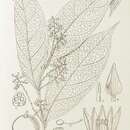en
names in breadcrumbs


Atroxima is a plant genus in the milkwort family (Polygalaceae). It is endemic to Western Tropical Africa.[1] It was first described in 1905 by Otto Stapf in the Journal of the Linnean Society.[2] It was initially in the Polygalaeae tribe before being split off with Carpolobia in 1992 to form the Carpolobieae tribe.[3] They are lianas or liana-like shrubs which produce shiny, orange, fleshy uni- to tri-locular berries, these can have an area of up to 5 by 5 by 4 centimetres (2.0 in × 2.0 in × 1.6 in).[4]
As of July 2020, there are 2 accepted species:[1]
Atroxima is a plant genus in the milkwort family (Polygalaceae). It is endemic to Western Tropical Africa. It was first described in 1905 by Otto Stapf in the Journal of the Linnean Society. It was initially in the Polygalaeae tribe before being split off with Carpolobia in 1992 to form the Carpolobieae tribe. They are lianas or liana-like shrubs which produce shiny, orange, fleshy uni- to tri-locular berries, these can have an area of up to 5 by 5 by 4 centimetres (2.0 in × 2.0 in × 1.6 in).